Ten Strange Self-Experiments
by Alex Boese
by Alex Boese
Self-experimentation is a controversial practice among scientists. On the one hand,
it can be noble for a researcher to use him or herself as a guinea pig, refusing to put others at risk. But on the other hand, it seems all too easy for the do-it-to-yourself ethos to shade uncomfortably into madness.
One starts to wonder, are the self-experimenters actually heroic, or are they just masochistic? Do they really need to inflict such punishment on their bodies? At times their actions resemble, more than anything else, those of the religious ascetics of old who tortured their flesh — whipping or starving themselves — believing that to do so was a way to purify the soul.
The list below is adapted from examples I wrote about at greater length in my book Electrified Sheep. This title was, in turn, a continuation of my exploration of bizarre scientific experiments that I began in Elephants on Acid. Both books are part of my 'weird science' series that includes, most recently, Psychedelic Apes.
One starts to wonder, are the self-experimenters actually heroic, or are they just masochistic? Do they really need to inflict such punishment on their bodies? At times their actions resemble, more than anything else, those of the religious ascetics of old who tortured their flesh — whipping or starving themselves — believing that to do so was a way to purify the soul.
The list below is adapted from examples I wrote about at greater length in my book Electrified Sheep. This title was, in turn, a continuation of my exploration of bizarre scientific experiments that I began in Elephants on Acid. Both books are part of my 'weird science' series that includes, most recently, Psychedelic Apes.
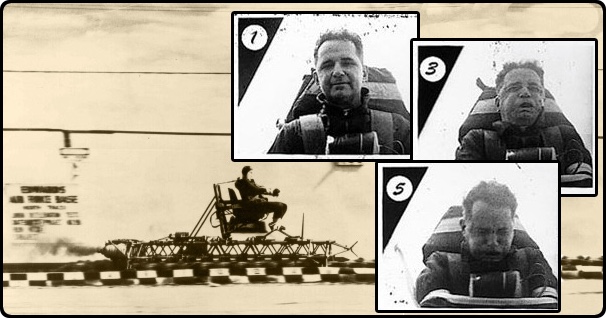
#10: The Decelerating Doctor
At Holloman Air Force Base in New Mexico, Stapp designed a rocket-powered sled that blasted down a 3500-foot track at speeds up to 750 mph before slamming into a pool of water that brought it to an abrupt halt. It went from 750 mph to zero in one second. Strong restraints made sure that the passenger didn’t continue their forward trajectory, though the restraints didn’t always work. One test dummy came free of the harness and was catapulted 700 feet through the air.
For his inaugural rocket sled ride, in 1947, Stapp traveled at a gentle 90 mph. The next day he advanced to 200 mph. And subsequently he kept upping his speed, probing the limits of human endurance. Over a period of seven years he rode the sled twenty-nine times.
Each time he rode the sled, the force of the deceleration hammered his body. He repeatedly endured blackouts, concussions, splitting headaches, cracked ribs, dislocated shoulders, and broken bones. One time, in a show of bravado, he set a broken wrist himself as he waited for medics to arrive. The greatest danger was to his eyes. Rapid deceleration causes the blood to pool with great force in the eyes, bursting capillaries and potentially tearing retinas. Even more disturbingly, when a human body comes to a stop that abruptly, there's a real possibility the eyeballs will simply keep going — popping out of the skull and flying onwards.
On Stapp's final ride on December 10, 1954, this almost happened. Nine rockets propelled him to 632 mph, faster than a .45 calibre bullet. He outran a jet flying overhead. And when the sled hit the water, Stapp experienced a record-breaking 46.2 Gs of force.
Stapp survived, but he later wrote of the experience, "It felt as though my eyes were being pulled out of my head... I lifted my eyelids with my fingers, but I couldn't see a thing." He feared he'd permanently lost his vision. Thankfully, his eyesight gradually returned over the next few days, but on account of that final ride, he suffered vision problems for the rest of his life.
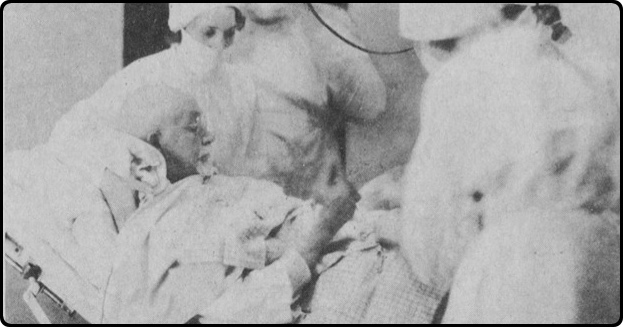
#9: The Self-Surgery of Evan O’Neill Kane
Kane propped himself up with pillows in order to get a good view of his abdomen. He injected cocaine and adrenalin into his abdominal wall, and then he swiftly cut through the superficial tissue, found the swollen appendix, and excised it.
The entire procedure took thirty minutes. There was only one slight moment of panic when part of his intestines unexpectedly popped out of his stomach as he leaned too far forward, but he calmly shoved his guts back inside his body and continued working. Kane later noted that he probably could have completed the operation even more quickly if it hadn't been for the air of chaos in the operating room as the hospital staff milled around, unsure of what they were supposed to do.
Kane enjoyed a full and swift recovery. Fourteen days later he was back in the hospital operating on other patients. He explained to the media that he had performed the self-experiment both to know how a patient feels when being operated upon, and to better understand how to use local anaesthesia to best advantage.
Emboldened by his success, when he needed a hernia operation eleven years later, at the age of seventy-one, he decided to self-operate again. Unfortunately, this second surgery proved more problematic. He never fully regained his strength, came down with pneumonia, and died three months later.
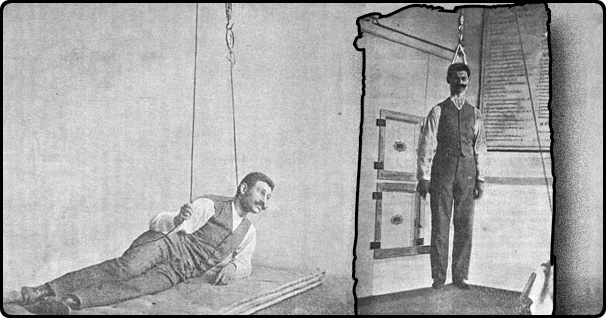
#8: Death by Hanging
Minovici began his self-hanging experiments by constructing an auto-asphyxiation device — a hangman's knot tied in a rope that ran through a pulley attached to the ceiling. He lay down on a cot, placed his head through the noose, and firmly tugged the other end of the rope. The noose tightened, his face turned a purple-red, his vision blurred, and he heard a whistling. He lasted only six seconds before consciousness began to slip away, forcing him to stop.
For the next stage of his research, Minovici brought in assistants. He placed the noose around his neck, then the assistants pulled the other end of the rope with all their might, lifting him several metres off the ground. Immediately his eyes squeezed shut and his respiratory tract pinched close. He signalled frantically to be let down.
In this first effort, Minovici lasted only a few seconds in the air before having to signal to be let down, but with repeated practice he eventually managed to endure twenty-five seconds of swinging by his neck.
But one final experiment remained — hanging from the ceiling by a constricting hangman's knot. Minovici tied the knot, again placed his head through the noose, and gave his assistants the signal. They pulled. Instantly a burning pain ripped through his neck. The constriction was so intense that he frantically waved the men to stop. He had only endured four seconds, and his feet hadn't even left the ground. Nevertheless, the trauma to his neck made it painful for him to swallow for an entire month.
Minovici’s later career wasn’t as masochistic. He developed an interest in Romanian folk art and founded a museum that exists to this day.
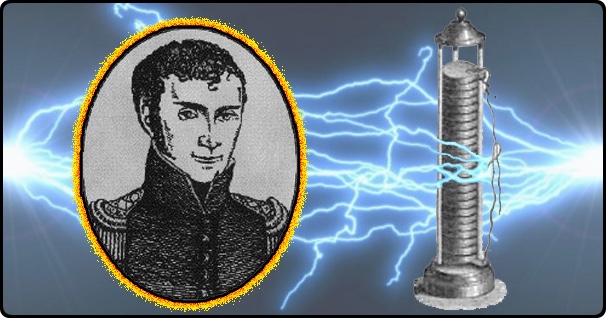
#7: The Man Who Married His Voltaic Pile
When a young German physicist named Johann Wilhelm Ritter subsequently learned of this amazing device, he decided to use it to explore the effects of electricity upon the human body — his own. He systematically applied the poles of a Voltaic pile to every part of his body.
Exposing his tongue to the current produced an acidic flavor. Shoving the wires up his nose made him sneeze. Touching them to his eyeballs caused strange colors to swim in his vision. And determined to make his investigation complete, Ritter also applied the current to his genitals.
This latter experiment proved rather pleasurable. He wrapped his reproductive organ in a cloth moistened with lukewarm milk, then applied the current. Swelling soon occurred, followed by climax. He had become a pioneer of electro-orgasm. This experiment was made stranger by the fact that Ritter would occasionally tell people he was marrying his Voltaic pile, such as when he wrote to his publisher, "Tomorrow I marry — i.e., my battery!"
If this were the entirety of Ritter's electrical self-experimentation, it might have been considered only slightly odd. But Ritter kept pushing onward — increasing the current to dangerous levels, forcing himself to endure longer periods of time, and using opium to dull the pain. As a result, his health suffered.
Repeated electrification caused his eyes to grow infected. He endured frequent headaches, muscle spasms, numbness, and stomach cramps. His lungs filled with mucus. He temporarily lost much of the sensation in his tongue. Dizzy spells overcame him, causing him to collapse. A feeling of crushing fatigue, sometimes lasting for weeks, often made it difficult for him to get out of bed. At one time, the current paralysed his arm for a week. And yet he continued on, boasting, "I have not shrunk from thoroughly assuring myself of the invariability of their results through frequent repetition."
His bizarre self-experiments shocked his colleagues. One reviewer of his work commented, "Never has a physicist experimented so carelessly with his body." Eventually the abuse took its toll. His weakened condition is believed to have contributed to his death from tuberculosis at the age of thirty-three.
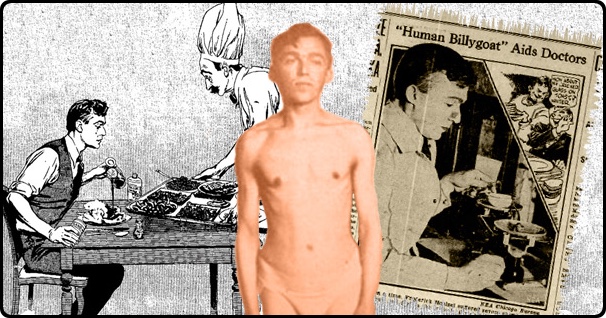
#6: Eating Glass
Later in his life, during the 1920s, while working as a researcher at the University of Chicago, Hoelzel put this talent for eating unusual substances to scientific use by ingesting a variety of inert materials in order to discover how quickly they passed through his intestines.
He scooped up gravel from the walkway outside the lab, swallowed it down, and recorded that it rattled out into his toilet fifty-two hours later. Steel ball bearings and bent pieces of silver wire each took approximately eighty hours to pass through him. Gold pellets moved at a leisurely pace through his intestines, only emerging after twenty-two days. Glass beads proved far quicker, rushing through his alimentary canal in a mere forty hours. His intestinal speed record was set by a piece of knotted twine that zipped through him in a mere one-and-a-half hours, aided along by a violent bout of diarrhea.
Hoelzel continued these unappetizing experiments daily for many years, well into the 1930s. In fact, Christmas was the only day of the year he would take a break from this grim fare, allowing himself a small, but plain meal of entirely digestible food.
The extreme diet left him skeletally thin. A reporter who visited the lab in 1933 wrote, "His hands are like those of an invalid, white, blue-linen and bony, his Adam's apple stands out from a scrawny neck, and his skin is colourless except for a network of fine blue lines, especially under his eyes."
Hoelzel never became a full professor, only attaining the rank of "Assistant in Physiology" at the University of Chicago. He was more widely known by the nickname the press gave him: The Human Billy Goat.
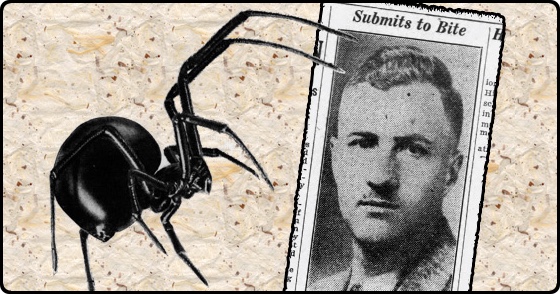
#5: Stung by a Spider
Blair later explained that he had decided to study the effects of the bite of the female black widow on man. But curiously, the effects of the bite were already well-known. Another entomologist, William Baerg, had conducted a similar self-experiment twelve years earlier, with the result that he had spent three days tossing and turning in a hospital bed, wracked by feverish pain. Despite being fully aware of Baerg's earlier work (and extreme suffering), Blair decided to allow the spider to bite him for twice as long as Baerg had risked. His agony, therefore, was proportionately greater.
Within minutes after the bite, Blair began to experience severe muscular cramps that made it difficult for him to breathe. Two hours later, he was writhing on the floor, perspiring profusely, and had to be rushed to the hospital. By the time he reached it, his blood pressure had dropped dramatically. The attending physician later commented, "I do not recall having seen more abject pain manifested in any other medical or surgical condition. All the evidences of profound medical shock were present."
Despite the agony he was experiencing, Blair insisted the hospital take electrocardiograms to determine the effect of the venom on his heart. He told the staff that it felt like torture to lie still as they hooked up their equipment, but somehow he forced himself to suffer through it, and the measurements were found to be normal, not differing significantly from ones taken two days before he was bitten.
Blair's misery didn't let up for several days. At one point, he became so delirious that he feared he was losing his mind. Thankfully, after a week the worst was over, and he was allowed to return home. However, he continued to experience an itching sensation all over his skin for several more weeks.
Based on this self-experiment, Blair concluded what may have seemed rather obvious to everyone else — that the bite of a female black widow spider is indeed "dangerously poisonous for man."
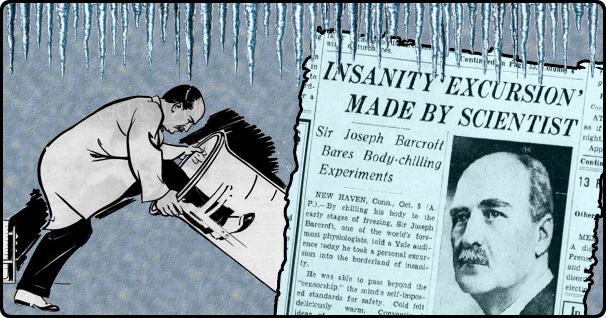
#4: A Cold Excursion
Some of Barcroft's early excursions included volunteering to be exposed to hydrocyanic acid gas (aka prussic acid) during World War I. A dog in the gas chamber with him died in ninety-five seconds, but Barcroft waited ten minutes before stumbling out with the dog in his arms.
A decade later Barcroft sealed himself inside an airtight glass chamber to test the effects of living in a low-oxygen environment. After six days in an atmosphere equivalent to that found at an altitude of 16000 feet, his entire body turned blue.
However, Barcroft's most dramatic excursion occurred in 1931 when he decided to investigate the effects of freezing on mental functioning. He stripped naked and lay down on a table in a refrigerated chamber in the Woods Hole Research Center. At first he shivered and curled up to stay warm. He found it difficult to maintain the willpower to remain in the room. He kept thinking, "I could just walk out of here now," but he persevered, and after about an hour a strange mental change occurred. All sense of modesty disappeared. Suddenly he didn't care if someone unrelated to the experiment might walk in and find him naked. The cold had turned him into a flagrant nudist.
But even more strangely, as he described to an audience at Yale University in 1936, "the sense of coldness passed away, and it was succeeded by a beautiful feeling of warmth; the word 'bask' most fitly describes my condition: I was basking in the cold."
Barcroft was certainly fast approaching a state of potentially lethal hypothermia. Thankfully a research assistant outside the chamber noticed something was amiss and rushed in with a blanket and warm drink to save him. Barcroft survived his ordeal without ill effect and lived to be seventy-four, at which age he dropped dead while riding a bus.
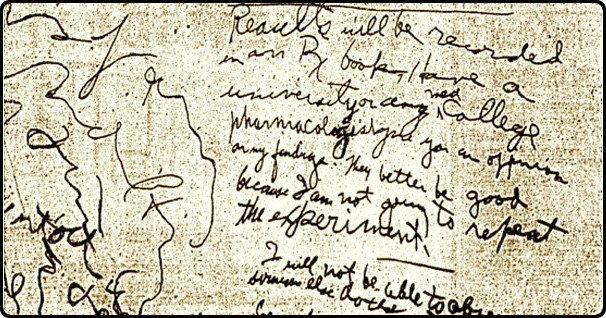
#3: Death Diary
Katskee scrawled the notes in no apparent order. It was possible, nevertheless, to piece together their chronology by the decreasing legibility of his handwriting. An early note recorded: "Eyes mildly dilated. Vision excellent." The cocaine caused bouts of paralysis and convulsions that came in waves. In between one of these bouts he wrote, "Partial recovery. Smoked cigarette." High up on the wall he scribbled, "Now able to stand up." And elsewhere: "After depression is terrible. Advise all inquisitive M.D.'s to lay off this stuff."
In one spot, in a shaky hand, he recorded his "Clinical course over about twelve minutes." This ended with the word "Paralysis," which tapered off into a wavy scrawl descending to the floor. It was probably the last word he ever wrote.
The press debated whether Katskee was the victim of a self-experiment that went wrong, or whether he had simply committed suicide. His family argued that his death was clearly a case of medical research gone wrong, pointing out that investigators had found an antidote at the scene, which, for some reason, Katskee had failed to give himself — perhaps the effects of the drug had prevented him from doing so.
Or perhaps Katskee had hoped to end his life in a way that would benefit science. In which case, his death was even more tragic, because when his notes were subsequently examined by one of his medical colleagues, the doctor concluded they were so incoherent as to be of no scientific value whatsoever.
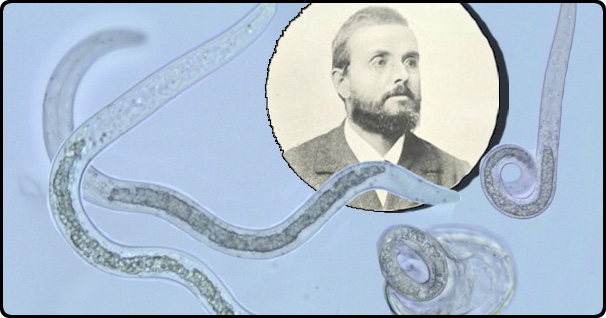
#2: A Diet of Worms
In order to conduct his experiment properly, however, Grassi first needed to determine that he wasn’t already infected. So he fished the eggs out of the intestines and placed them in a solution of moist excrement, where he could keep them alive indefinitely. Then he microscopically examined his own feces every day for almost a year to confirm his lack of infection.
Finally, on July 20, 1879, he felt confident he was free of worms. So he spooned one hundred of the eggs out of their fecal home and swallowed them down. A month later, much to his pleasure, Grassi experienced intestinal discomfort and then found eggs in his stool. His experiment had been a success. Having confirmed his infestation, he treated himself with an herbal anti-worm medicine and flushed the immature parasites out of his body.
After the example set by Grassi, self-infection with worm eggs became something of a gruesome rite of passage among parasitologists. In 1887, Friedrich Zschokke and his students at the University of Basel ingested tapeworm eggs and grew worms up to six feet in length in their intestines. In 1922, the Japanese paediatrician Shimesu Koino set a record by consuming 2000 mature Ascaris lumbricoides eggs, giving himself such a full-blown infection that he began coughing up larval worms from his lungs. And as late as 1984, the Soviet researcher V.S. Kirichek reported sampling worm eggs he found in the brains of arctic reindeer.
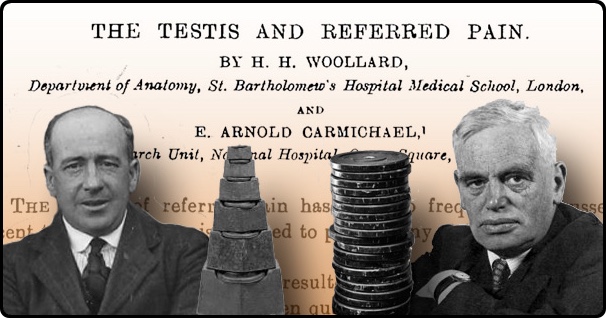
#1: The Sensitive Testes
Their motive for this self-experiment was to better understand referred pain — the mysterious phenomenon in which injury to an internal organ causes pain to be felt elsewhere in the body. For instance, a heart attack may cause a sensation of pain in the arm. The two doctors noted that, of all the internal organs, the testicles were the most "accessible to investigation" and therefore seemed ideal for a study of referred pain.
During the experiment, the subject lay spread-eagled on a table, exposing his genitals. His colleague stooped over him and gripped the other man's scrotal sac, drawing it forward and gently cradling it in his hand. He then rested a scale pan on a single testis and carefully piled weights onto the pan, recording the reaction of the subject with each increase of weight.
Their results, which appeared in the journal Brain, were rather spare on colorful details. They described the agony of the victim only in dry, clinical language. For instance, they reported that 300 grams of weight produced slight discomfort in the right groin, while 650 grams caused severe pain on the right side of the body. However, they did confirm that injury to the testicles does cause pain to be referred throughout the body. For instance, as the weight on the testicle increased to over two pounds, the subject reported pain "of a sickening character" not only in his groin but also spreading across his back.
Woollard and Carmichael conducted a number of variations of the experiment in which they numbed nerves leading to the testes in order to determine how this would alter the sensation. This produced the interesting finding that, even though they eventually numbed what they believed to be every nerve leading to the testes, they couldn't entirely abolish the pain of compression. The testes are highly sensitive organs!
Their results remain the definitive word on this subject since no other scientists have ever repeated the experiment.

